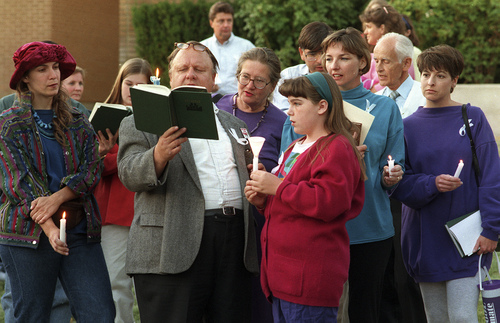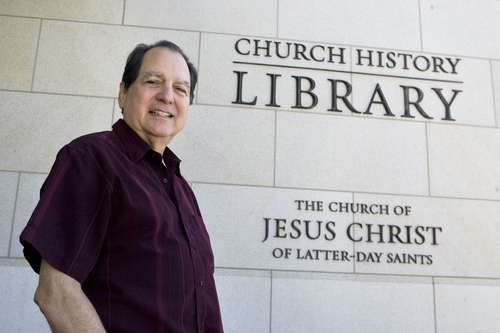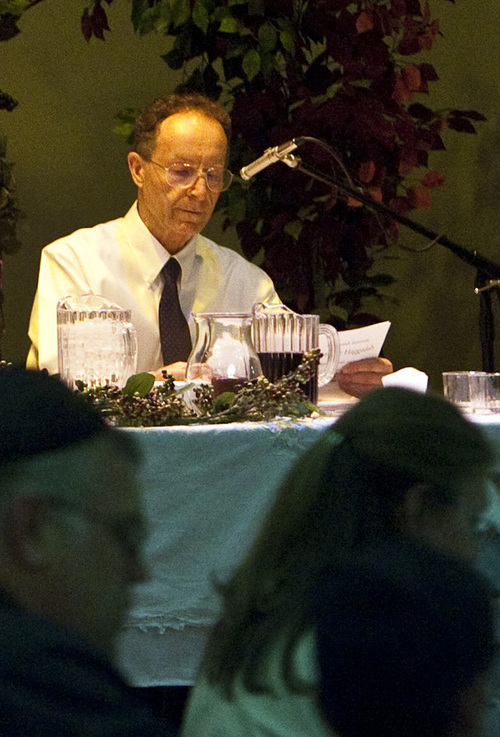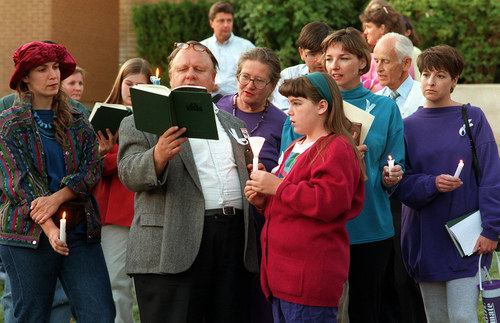This is an archived article that was published on sltrib.com in 2013, and information in the article may be outdated. It is provided only for personal research purposes and may not be reprinted.
D. Michael Quinn is the kind of Mormon who sees God's hand in ordinary moments, who believes he was miraculously healed of polio, who thought he might one day be an LDS apostle, and who still feels a "burning in his chest" that he interprets as spiritual promptings.
Quinn is the kind of researcher whose obsessive interest in the Mormon past compelled him to read every church authority's journal, to scour the country's libraries and private collections for LDS documents and to analyze every anti-Mormon pamphlet he could find, hunting for ways to justify contradictions between simplified official accounts and messy human history.
The accomplished scholar and lifelong believer naively assumed that these two halves of his personality were complementary, that he would use them to build up the faith he loved.
In reality, Quinn's twin passions were on an inexorable collision course from his teen years in the 1960s until September 1993, when the Yale-trained historian was drummed out of The Church of Jesus Christ of Latter-day Saints for apostasy.
That same month, four other writers and feminists were excommunicated and one was disfellowshipped, a less-severe punishment. Together, they became known as the "September Six."
Of them, Quinn is arguably the most tragic figure.
He appeared to have the most literal faith (believing in angelic visits, gold plates, Christ in America) and the greatest ambition (seeing himself as the next church historian and maybe as a general authority).
Instead, Quinn, 69, has not had an academic appointment or steady income in more than a decade, and, though he still considers himself a believing Mormon, he has no community of faith.
"He may know more about the Mormon past than anybody alive," says Jan Shipps, a Methodist and a pre-eminent scholar of Mormon history. "He could have had a successful career at Brigham Young University if he had been willing to give up his research in LDS Church history and just teach."
But Quinn couldn't do it.
"Mike is an idealist," says Elbert Peck, who was editor of Sunstone, a magazine for intellectual Mormons, at the time of the September Six. "He believed that Mormonism would eventually embrace the historical truths that he was discovering and be able to deal with the tensions like he did."
Quinn was wrong about that — or maybe just ahead of his time.
—
Teenage defender of the faith • When Quinn was 5 years old, his Mexican Catholic father and his Anglo-Swiss, sixth-generation Mormon mother divorced.
Young Mike, a precocious only child, was reared by his mother in the Los Angeles area with Mormonism as his cocoon. Shortly after the divorce, he contracted polio, he told a Sunstone audience in 1994, and, before going to the hospital, was blessed by a Mormon high priest and ultimately suffered no lasting effects from the disease. He was healed by faith, he believes.
Another time, Quinn got separated from his LDS youth group in a cave and heard a voice say, "Stop." When the leaders found him, he was standing on a ledge with a sheer drop just inches away. In his view, another miracle.
By regularly sharing these stories at church, Quinn came to be seen as unusually attuned to the whisperings of the Holy Spirit, a religious rock star of sorts in his Mormon ward, or congregation.
At the same time, the future historian spent hours and hours of his youth at the library, checking out 20 books at once — especially biographies of U.S. presidents and World War II icons.
When he began to experience stirrings of attraction for other boys at age 12, he did what he knew best: read everything on the topic.
Quinn looked in the card catalog under "pervert," he told David Haglund of Slate magazine, "which was the word his grandmother had used after he told her that another kid at church had been groping him."
Under "perversion," it said, "see homosexuality."
From that day on, Quinn says, "I privately defined myself as a 'homosexual,' but confided in no one but God. I knew it wasn't what God wanted for me so I decided to live a straight life."
Five years later, Quinn's interest in Mormon history was ignited by poring over official accounts, such as the multi-volume "Comprehensive History of the Church," while coincidentally discovering the work of critics.
In "Family Kingdom," for example, Samuel W. Taylor wrote a lively and compelling story of his father, John W. Taylor, who had been forced to resign from the Quorum of the Twelve Apostles in 1905 for taking more wives after 1890, when Wilford Woodruff, then the president of the LDS Church, issued a Manifesto declaring an end to the faith's practice of polygamy.
Though other LDS leaders also disregarded that proclamation, Taylor and another apostle were the only ones disciplined.
Samuel Taylor, the biographer, felt his father had been scapegoated — and that bothered Quinn. When Mormon apostle LeGrand Richards spoke to an informal gathering of young people in Quinn's Southern California ward on New Year's Eve 1962, the young man asked about Taylor's treatment.
"John W. Taylor was a very proud man," Richards told Quinn, "who felt that because his father [John Taylor] had been president of the church, he could do whatever he felt like doing."
The apostle's response resonated with Quinn, who even at an early age understood such pride — personally.
"I have always been ashamed and felt guilty about it, but arrogance is as much a part of me as my faith," Quinn says. "My faith, my homosexuality and my arrogance have been burdens to me my whole life."
Although Richards' answer satisfied him for a season, the young historian would return again to the question of post-Manifesto polygamy.
—
A spiritual addiction • Quinn was an English major at LDS Church-owned Brigham Young University in 1962, in love with stream-of-consciousness novels and existential philosophy. But every spare minute was spent in the library's Special Collections.
"Church history was only a hobby," he recalls, "but it was consuming."
At 19, Quinn left for his two-year Mormon mission, serving in Britain under President Marion D. Hanks, who later became an LDS general authority and a lifelong mentor to Quinn.
While traveling in a van with nine other missionaries one day, the newly minted missionary announced to the group that "the church made only 16 doctrinal changes in the Book of Mormon between 1830 and our current edition."
Quinn's statement was met with dead silence.
"I thought I was reassuring the missionaries of my district with faith-promoting answers," he explains, "but I realized in that moment that not everyone saw my answers that way."
Quinn became a mission leader, an ordinance worker in the London LDS Temple and the go-to guy for tough assignments in the British Isles.
Upon his return to BYU, Quinn continued his English studies while working as a teaching assistant in Book of Mormon classes, a Salt Lake Temple worker, a Sunday school teacher and a guide on Temple Square.
In June 1967, Hanks officiated at Quinn's temple marriage. (The couple eventually had four children.)
During the early years of the marriage, he continued to read anti-Mormon publications that used historical details to undermine the church's account.
"I checked every quote and citation for accuracy and context," Quinn said in his Sunstone address."I prayed for the Lord to guide me by his Spirit to learn the truth of these matters and to know how to present them in a faithful way."
He felt called to this work.
—
Merging personal and professional goals • After graduating from BYU in 1969, Quinn enlisted in the military rather than wait to be drafted and spent 18 months in Germany, learning counterintelligence techniques and reading classified U.S. documents.
Though he had been accepted to Duke for a graduate degree in English after his discharge, he realized he was more interested in Mormon history. So he enrolled for a master's degree at the University of Utah.
During his first graduate semester in 1971, Quinn was hired as a research assistant to Davis Bitton, then a professor at the U. and an assistant LDS Church historian under Leonard J. Arrington. Quinn was assigned to read and research hundreds of newly available LDS general authority diaries.
It was a task that matched his talent for meticulous note-taking. He photocopied thousands of pages, cross-referencing details from one source to the next. His high energy and astounding memory amazed his superiors and made his work invaluable.
While there, he also penned a lengthy brochure critiquing the work of anti-Mormon publishers Sandra and Jerald Tanner. His pen name: Dr. Clandestine.
Soon, there was talk of him as the "prince-in-waiting," Shipps recalls. "Everyone thought he would one day replace Leonard [Arrington]."
At the same time, the prediction that he was meant to be a high LDS leader haunted Quinn. He sought an interview with then-President Spencer W. Kimball to dispel the notion forever. Instead, Kimball "promised me that one day God would call me as an apostle," Quinn told the Sunstone crowd.
After the blessing, Kimball told him "not to work for the office or try 'to curry favor' with church leaders, but just to live as I felt the Lord desired for me."
Two months later, Quinn, who had finished his master's degree, went to Yale for doctoral work in history, while serving as a bishop's counselor and LDS Institute of Religion teacher. In 1975, he wrote his dissertation about the dynamics of power among the Mormon hierarchy.
His advisers at Yale granted him a rare departure in academia by allowing him essentially to bear his testimony — of Mormon founder Joseph Smith and of the LDS account of supernatural events — in his dissertation's preface.
They knew Quinn expected to return to Utah and felt that opening with a declaration of his faith would help him gain an appointment with the church.
By then, though, Arrington's funds and influence had faded, so Quinn took a job at the "Lord's University" — BYU.
—
Clash of titans • In 1981, Quinn was a popular professor on the Provo campus and again serving in LDS leadership roles when LDS apostle Boyd K. Packer — who had interviewed him for the BYU job — gave a stirring public rebuke to professional historians and others called "The Mantle Is Far, Far Greater Than the Intellect." In it, Packer decried those who would put their scholarship above Mormon authorities.
A student group invited Quinn to offer a rebuttal, which he called "On Being a Mormon Historian," and which was published against his wishes by the Tanners, his earlier nemeses. The speech and attendant publicity — including a Newsweek feature — put Quinn in Packer's sights.
The problem in the late 1970s and into the '80s, Shipps says, was that Mormon authorities and church historians, though themselves believers, had conflicting goals.
LDS leaders were dealing with waves of new converts across the globe who needed the LDS story to be simple yet compelling so they could fully embrace it.
"The apostles wanted historians to create a history that was heroic so converts would want to take on a Mormon ethnicity," Shipps says. "If they didn't begin to see themselves first as Mormons, they didn't stay long."
But historians such as Arrington and Quinn were trying to humanize, not lionize, early Mormons and to provide context for the religion's troubling episodes. They hoped to legitimize the field to other scholars.
For Quinn, the tipping point was his exhaustive 1985 article in Dialogue: A Journal of Mormon Thought, documenting post-Manifesto polygamy and how LDS leaders tried to cover it up.
Shipps heard one church employee describe Quinn's piece as "two pages of saying, 'These men are prophets and I honor and respect them,' followed by 76 pages of 'They lied and lied and lied,' and then the last two pages of 'These are honorable men and prophets of my church.' "
In response, Quinn's LDS stake president — who Quinn believes was directed to do so by Packer — reluctantly asked the professor to relinquish his Mormon "temple recommend," which meant he no longer could participate in sacred rituals that had been so meaningful to him.
That same year, Quinn and his wife separated and eventually divorced due to his homosexuality — though they remain friends, he says, to this day.
Three years after the Dialogue article, Quinn says, school officials were making his academic life tough, denying him sabbaticals and research time. The message seemed clear: Stop your work on Mormon history or lose your job.
He resigned.
"I won't be intimidated by anyone," Quinn says. "I was uppity at the back of the church bus."
He still felt he had a dual mission and that his work would be welcomed elsewhere.
Wrong again.
—
Church of one • Since Quinn's departure from BYU and subsequent excommunication, he has written several books, including a second volume on LDS hierarchy, one on Mormonism and the "magic worldview," and a look at same-sex dynamics in LDS history.
Early on, he had research grants at places like The Huntington Library in Southern California along with short-term academic stints at Claremont Graduate University, Indiana University-Purdue University at Indianapolis, and Yale, where he had sold his copies and notes on LDS diaries. He continues to research Mormon history, including at the church's Salt Lake City archive, where kindly senior missionary couples call him "Brother Quinn."
In recent years, however, Quinn has been a finalist but never chosen for academic appointments in the burgeoning field of Mormon studies. He believes he has been blackballed by high-powered LDS donors who do not want an excommunicated member using their money.
Ironically, many of today's Mormon historians are again delving into the church's controversial past — and with the faith's blessing — to counter Mormon critics who take to the Internet to expose early LDS authorities' foibles. Post-Manifesto polygamy has even been discussed in church-sponsored periodicals.
So would Quinn still be excommunicated today for the issues he raised back then?
No one knows, of course.
Quinn would not return to the LDS Church now because of issues such as its stance on gays, he says, but remains a believer in the founding events of Mormonism — Joseph Smith's First Vision, the Angel Moroni, and that the Book of Mormon and Doctrine and Covenants are "God's revelations."
"I believe the LDS Church today, though deeply flawed, is still God's true church run by the damned human race," he says. "There is no limit to my Mormonism. It's like St. Peter's Basilica, embracing all truth with open arms."
Even so, the historian, who describes himself as a medieval mystic alone in his faith, does not regret the path he took.
"I don't believe that the 'Holy Spirit of Promise' ratified my excommunication, but I do believe it ratified all the other ordinances I received," Quinn says. "The Spirit is still part of my life."
He feels the burning — even as he speaks.
Where the other five are now
Lynne Kanavel Whitesides, who was disfellowshipped for comments she made on television about how the LDS Church treated women, is now a professional life coach: "Being disfellowshipped from the LDS Church was one of the best things that ever happened to me. It opened up a world of spirituality I didn't even know was possible."
Lavina Fielding Anderson, who was excommunicated for publishing a list of attacks on intellectuals by LDS leaders, is president of Editing, Inc. and continues to attend the same Mormon ward she did in 1993: "Being excommunicated is something I think of or am reminded about every single day. It's like a death; I haven't gotten 'over' it. It hasn't become irrelevant. But it has turned my heart even more to the plain and precious part of Christ's love, grace and atonement. My LDS ward, by accepting me, allowing me to serve where I can, and respecting what I can offer has, in significant ways, canceled the exclusion that usually accompanies excommunication. They've helped me stay Mormon."
Paul Toscano, a consumer bankruptcy lawyer, was excommunicated for critical comments he made about LDS apostles in public: "My wife, Margaret Toscano, who was targeted first, was eventually excommunicated on Nov. 30, 2000. Our children are all adults and disaffected from the church. We don't go to church but worry about it. My story will soon be published as an ebook, 'Road to Exile: Memoir of a Mormon Excommunicant.' I'm a Christian with doubts."
Maxine Hanks, a chaplain and independent scholar who lectures and writes on religious studies, was excommunicated for public writings and speeches about Mormon women and religious authority. Hanks was rebaptized in 2012: "After my excommunication, I undertook a personal spiritual path exploring other faiths and ministries, to find deeper answers about myself and women's priesthood. I felt spiritually led back to the LDS Church as a necessary part of that journey to completion and wholeness. I found membership to be even more rewarding than I had expected."
Avraham Gileadi, a Hebrew scholar who was excommunicated for some of his writings about Isaiah, kept the lowest profile. He was rebaptized into the LDS Church in 1996 and continues to write for a Mormon audience: "In my case — not a single charge was true or supported by evidence — and all mention of it was expunged from the church's records. I'm fully active in the church and gospel and have continued to publish books, including my last major work on Isaiah, the Apocalyptic Commentary of the Book of Isaiah, published at the end of August, exactly 40 years after coming to the U.S. I have been in Washington since April but may return to Utah. I hope for the day that zealous Mormons will no longer be treated as anti-Mormons."
Peggy Fletcher Stack











